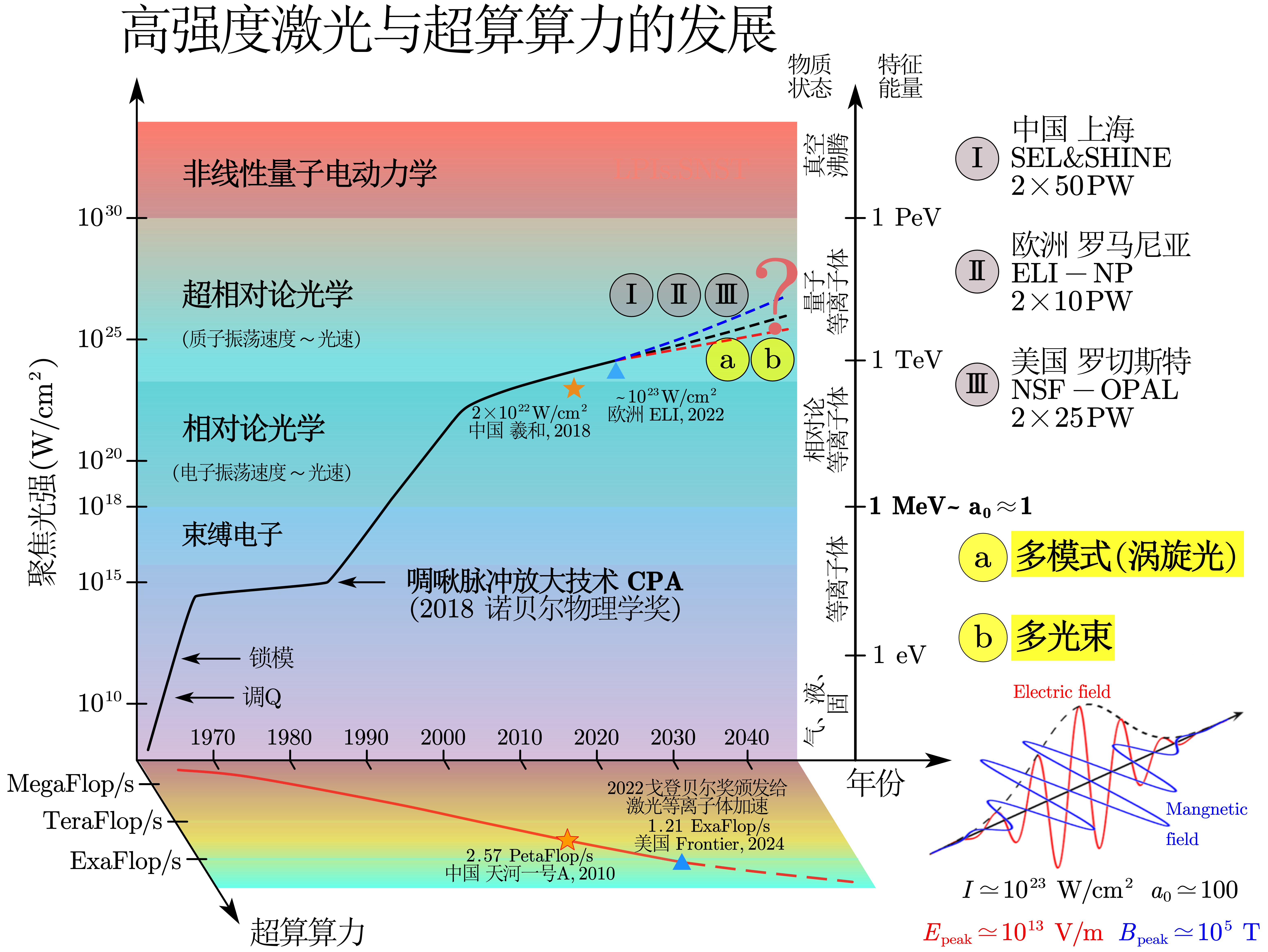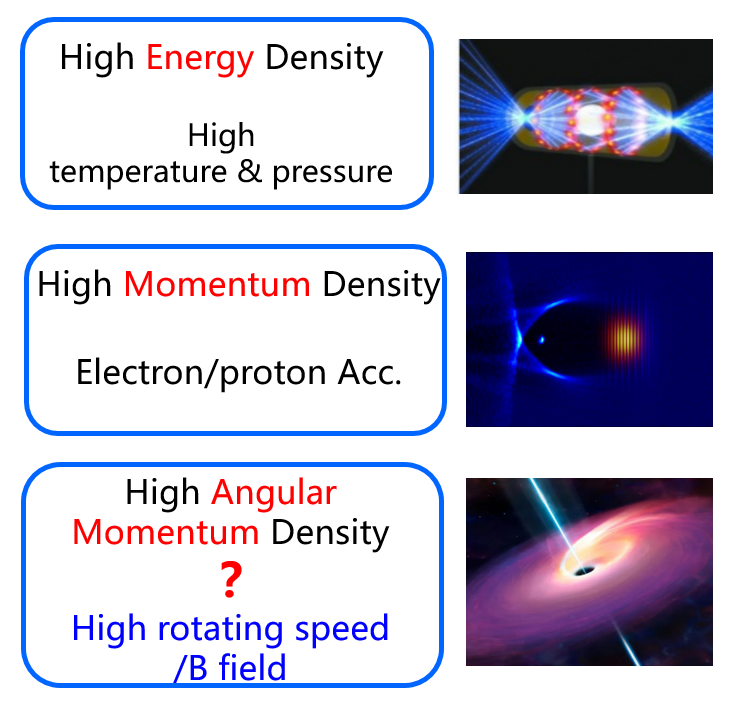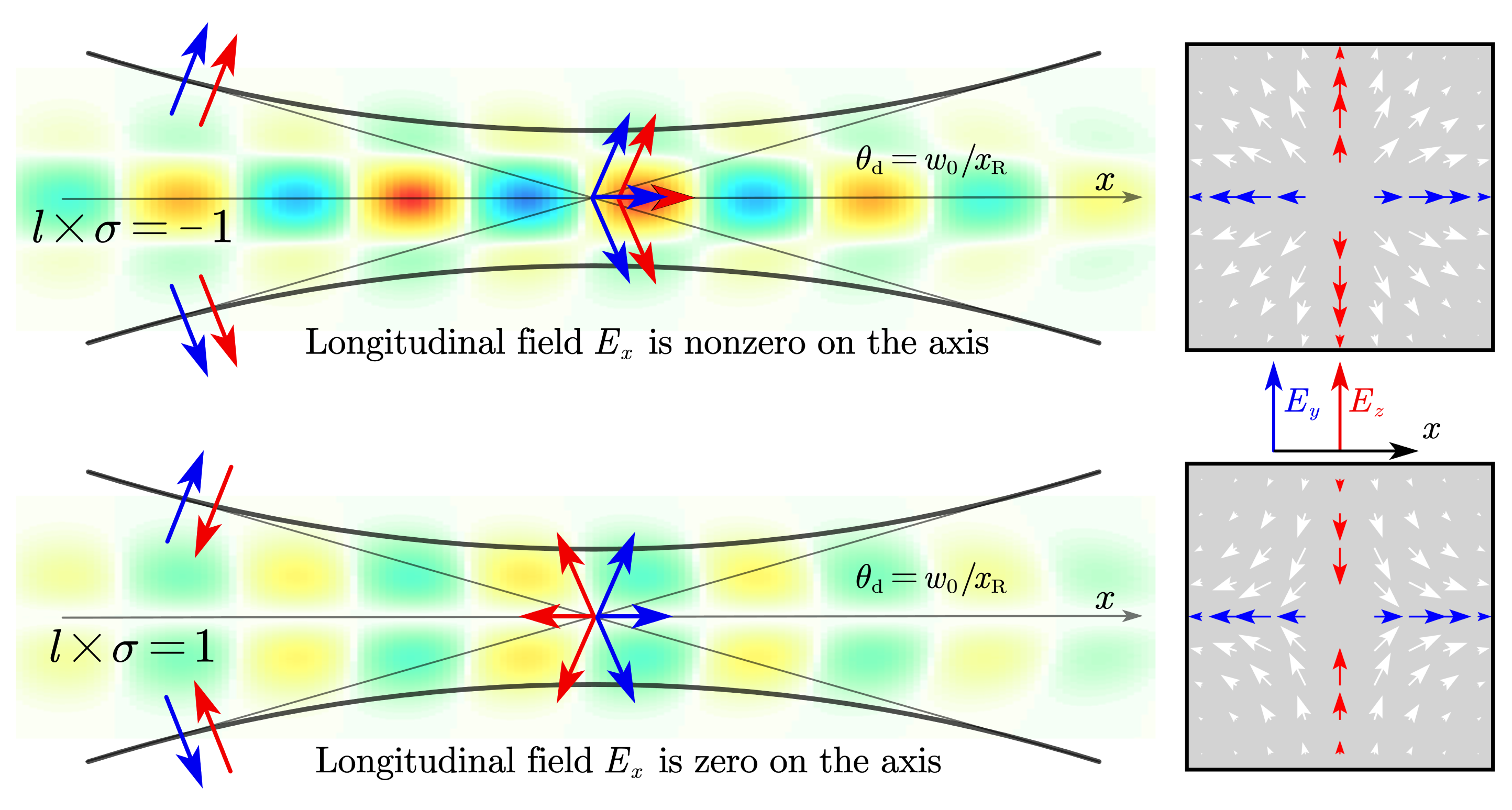研究方向
激光等离子体物理,强场激光物理,高能量密度物理 (点击可了解详细内容)
在过去二十多年里,超高功率激光技术有了迅速的进展,催生了一批重要成果。为此,世界各科技强国都建造了或计划建造高强度大型激光装置,这包括中国在上海已建成的10拍瓦和计划建造的100拍瓦激光装置、欧洲的三个旗舰激光装置(极端光学装置ELI,Extreme Light Infrastructure)等。我的研究利用在国家超级计算机上运行的PIC(Particle-in-cell)模拟和相关理论来研究强激光与等离子体相互作用。相关结果的潜在应用包括粒子加速、X光辐射、自生磁场、可控核聚变和实验室天体物理等。更多背景见主页的“科学研究”。本小组也与国内外各大实验室建立有合作关系。
Key words:
Laser-plasma interactions, electron acceleration, direct laser acceleration, vortex lasers, tight focusing, high-energy ps-pw lasers, X-rays, plasma wakefield acceleration, ion acceleration, relativistic mirrors, self-generated magnetic fields, (nonlinear) Thompson scattering, optical diagnostics, Plasma diagnostics, fast ignition ICF, plasma optics, strong field QED, coherent structure, laser (beam) plasma instabilities, proton imagination, HHG from laser solid plasma, OAM, PIC simulation, intense quantum light (photon kinetic theory), HED science, fast beam transport in plasma.
Vladimir Tikhonchuk’s Conclusion in the book of 《Particle Kinetics and Laser-Plasma Interactions》2023
The physics of laser-plasma interactions is a fast-developing domain of science. New ideas and exciting results appear every year. The aim of this book is to provide a solid background for people interested in participating in these research activities and making their own contributions, either in theory, numerical simulations, or experiments. This notion of a solid theoretical background guided me in choosing the subjects to cover and the examples to discuss. Many exciting results are not included in this work because either they are still evolving and need more time to be ready for review or simply because the domain is too large to cover in this book.
I would like to mention several promising topics that are omitted here. One is the interaction of multiple laser beams with plasma, excitation of plasma modes common to several incident beams, and interaction with plasmas of vector laser beams or beams with a complex wavefront. The overlapping of several laser beams is an indispensable feature of ICF experiments, which requires new developments in the physics of parametric instabilities and controlling the nonlinear effects. The laser beams carrying an orbital angular momentum, complex polarization, or temporal and spatial chirp have a strong potential that is already demonstrated in nonlinear optics, and they will soon be implemented in high-power and high-intensity laser facilities. The challenge is to understand how these new laser technologies may affect the laser-plasma interaction, the efficiency and quality of laser energy deposition, excitation and mitigation of parametric instabilities.
The physics of magnetic field generation, electron and ion acceleration in laser and plasma waves also merits a more detailed analysis and much better comprehension and characterization. Kinetic simulations with VFP and PIC codes show a complicated competition of collisional and collisionless processes that are not yet fully understood. The self-generated magnetic fields affect the energy spectrum of accelerated particles, angular distribution, and energy partition. This concerns the competition of electron and radiation transport in the high energy density physics experiments and also ion kinetics in high-temperature, high-density fusion plasmas. Many new impressive results will come in this area in the near future.
参考书目:
1) 《强场激光物理》沈百飞,科学出版社(2023);
2) 《Particle Kinetics and Laser-Plasma Interactions》,Vladimir Tikhonchuk 2023;
3) 《A Superintense Laser-Plasma Interaction Theory Premier》 Andrea Macchi 2013;
4) 《Laser acceleration》T.Tajima, La Rivista del Nuovo Cimento 2017;
5) 《Physics of high-intensity laser-plasma interactions》 P. Gibbon, RIVISTA DEL NUOVO CIMENTO 2012;
6) 《Unifying Physics of Accelerators, Lasers and Plasma》,Andrei Seryi 2015
7) 《The Physics of Laser Plasma Interactions》 William L. Kruer, Westview Press;
8) 《Applications of Laser-Driven Particle Acceleration》CRC Press 2018 ;
9) 《惯性聚变物理》,Stefano Atzeni &Jürgen Meyer-ter-Vehn合著,沈百飞翻译,科学出版社于(2008);
10) 《An Introduction to ICF》, S.Pfalzner (2006), CRC Press;
11) Innovative Education and Training in high power laser plasmas (PowerLaPs) for plasma physics, high power laser–matter interactions and high energy density physics – theory and experiments;
Innovative education and training in high power laser plasmas (PowerLaPs) for plasma physics, high power laser matter interactions and high energy density physics: experimental diagnostics and simulations;

本团队主要面向未来的新型高功率激光技术(比如多模式)和装置能力升级(比如多路激光协同工作),从角动量驱动的强磁场生成和涡旋强激光的加速效应等方面展开;同时也探索基于涡旋光的新型诊断原理和等离子体调控、新型PIC算法和面向下一代强激光和XFEL的SF-QED效应。可以归结为一下三个面向:
1)面向激光聚变和能源的研究,我们主要关注利用皮秒/千焦耳激光与等离子体相互作用,通过不同的电子加速机制(比如激光直接加速电子DLA)产生高流强的快电子和强磁场等,为未来高增益聚变方案提供快点火源。
2)面向工业和医学应用的研究,我们主要关注利用飞秒/焦耳激光与等离子体相互作用,产生高品质电子束(快脉冲、大电荷量等),进而产生X/伽马辐射,为尖端制造、材料检测、食物安全、生物医学等提供经济、方便的诊断源。这部分也可与传统加速器的成熟技术,比如束流技术和存储环技术等进行结合。
3)面向前沿基础物理的研究,我们主要关注利用未来百太瓦激光与硬自由电子激光XFEL等极端光装置,研究辐射反作用力和中子自旋作用力等相关内容的实验方案和测量方法。
以上三个面向中涉及到的理论,主要是以光电相互作用为主,从最根本的强场激光与单电子相互作用,到激光与等离子体中电子的集体相互作用。涉及到电子的加速机制(比如激光直接加速电子、等离子体尾场加速电子等)、高能电子的辐射机制(比如回旋辐射、渡越辐射等)、快电子在等离子体中的传输机制(比如自生强磁场的影响等)以及高能电子在极端加速场中的强场效应(比如辐射反作用力和自旋力)等。除了理论,使用最多的工具是基于超算算力的PIC模拟程序,包括开源的和合作自主开发的。
具体的研究内容可列举三方面: 1 强磁场和高速旋转环境;2 高品质电子束和X光束;3 新诊断方法的探索和等离子体调控。针对高功率激光等离子体,我们需要加速原始创新、跨学科知识、不同技术之间的融合,从而最终加速聚变能研究中点火方案的探索、工业医疗中紧凑型粒子束和辐射源的技术研发、以及基础等离子体物理的知识与技术等。


1 强磁场和高速旋转环境
近年来,大型激光装置上的强磁场带来了许多新的研究机遇,包括高能量密度物理、核聚变物理和实验室天体物理等。实验室天体物理有关的研究内容有磁重联、粒子加速等。尤其,天空环境充满磁场分布,许多天文现象都与磁化等离子体有关。以往产生轴向准直强磁场的方法有,逆向法拉第效应、激光驱动线圈、内爆磁场放大等。其中,逆向法拉斯效应带来的自生磁场,有其相对的简单性和易操作性。传统的逆向法拉第效应是基于圆偏振激光光子的吸收。尽管从轨道角动量(Orbital Angular Momentum, OAM)守恒角度较容易理解,但涉及到吸收机制、提高产生磁场强度等问题仍然有待研究。高功率激光携带的角动量可以达到超高密度,这使得与之相互作用的物质也可能因此具备高密度的角动量。这个发生过程可能的时空范围通常在(1~100微米)和10~1000飞秒量级。我们将通过理论和PIC(Particle-in-Cell)模拟,利用涡旋光束或多光束环境,寻找更高效的OAM传递机制,从而产生更高的准直自生强磁场,并分析等离子体携带OAM的分布和生成几特斯拉甚至上千特斯拉强度的准直强磁场。由于其准直的拓扑结构相对简单,我们期望在大型激光装置产生的强磁场和高速旋转等离子体环境中,对高能量密度等离子体将产生显著影响,比如质子加速、热电子输运等,从而为激光惯性约束聚变方案带来改变,同时也模拟更丰富的天体现象。这部分我们也会探索一些强场效应,尤其考虑到强磁场的环境,比如辐射反作用力(radiation reaction)。



Ref.
(1)Y. Shi* et al. PRL 121, 145002 (2018);
(2)Y. Shi, Baifei Shen* et al. PRL 112, 235001 (2014);
(3)Y. Shi* et al. JUSTC 53, 3(2023);
(4)D. R. Blackman et al. PoP 29, 072105 (2022);
(5)Y. Shi et al. NJP. 22, 073067 (2020);
(6)Y. Shi* et al. PRL 130, 155101 (2023);
(7)T. V. Liseykina et al. NJP 18, 072001 (2016).
(8)Yin Shi * et al. Sci. China-Phys. Mech. Astron. 67, 295201 (2024) (Invited Review).
(9)Jue Xuan Hao, Xiang Tang, Alexey Arefiev, Robert J. Kingham, Ping Zhu, Yin Shi*, and Jian Zheng, Matter Radiat. Extremes10, 017201 (2025)(封面).
2 粒子束和光子束
短脉冲(fs~ps)的高功率激光已被证明在加速电子,以及加速重离子、产生高能光子等方面具有显著优势。这个优势的基础就是,超短超强激光脉冲,波长是微米量级的中红外,可以聚焦在极小的时空范围内,从而以极高梯度传递能量和动量。基于微波、射频的加速,由于其波长大几个量级,其加速梯度天然更小。更大的加速梯度,也就面临加速物质的毁坏,从而在我们的情况下也就是等离子体状态。超短超强激光驱动等离子体尾波加速产生的高能电子束已被证实其品质足以产生深紫外的自由电子激光。与此同时,激光直接加速产生低能、高电荷量的热电子束,是重离子加速、次级辐射(比如X光)、惯性聚变点火等领域的关键。已有的研究表明相对论强度的涡旋光束在紧聚焦情况下,轴向电场和轴向磁场也可以到达相对论量级。利用得到的轴向场,可以加速获得亚飞秒的高能电子脉冲链。而轴向场和中空的有质动力势结合,也可能为热电子的发散角改变带来额外的调控。同时,多光束协同作用产生的自生强磁场可以对热电子产生导引作用。


Ref.
(1)Y. Shi* et al. Phys. Rev. Lett. 126, 234801(2021);
(2)Y. Shi*, Plasma Phys. Control. Fusion 63 125032(2021)(2025年 PPCF Outstanding Paper Prize - Plasma Physics and Controlled Fusion - IOPscience);
(3)Y. Shi*, High Power Laser Sci. Eng. 10, e45(2022)(封面文章);
(4)Y. Shi, Baifei Shen* et al. PRL 112, 235001 (2014);
(5)D. R. Blackman, Y. Shi et al. Commun. Phys. 5:116 (2022);
(6) Yin Shi * et al. Sci. China-Phys. Mech. Astron. 67, 295201 (2024) (Invited Review).
中科大、上师大、美国UCSD合作发表强涡旋光激光等离子体物理综述 (qq.com)
(7) Yin Shi, Baifei Shen*, et al. ,Phys. Plasmas. 20, 093102 (2013).
3 新诊断方法的探索和等离子体调控
等离子体诊断手段中,电磁场的散射占据了重要角色。频谱和偏振都携带可提取的信息,也是常见的测量目标。与此同时,光场的波前态也携带着额外信息。比如常见的涡旋光,又称轨道角动量(Orbital Angular Momentum, OAM)光或Laguerre Guassian(LG)光。涡旋光已在量子光学、光通信等领域获得较多研究。但等离子体诊断中尚未有人明确提出利用电磁场的波前测量。对于额外维度的信息测量,总是有望获得更多的信息。尤其考虑到等离子体中的涡旋波、磁化效应等,利用已有的诊断手段不能很好地获得信息。探索OAM的测量来诊断等离子体就显得很有必要。我们主要关注等离子体中的波粒相互作用,研究等离子体波、超热电子、自生磁场等分布的诊断,从而增加我们对基础等离子体的理解,并最终有望用于可控聚变等领域。在最前沿的强场QED的研究中,新的诊断方法也需要提出来测试相关理论。诊断手段的提升非常有利于我们对背后物理的理解进而借助光束制备来调控等离子体状态,能极大促进高能量密度物理的研究。大型计算和模拟,也对于新型诊断原理的探索至关重要。

